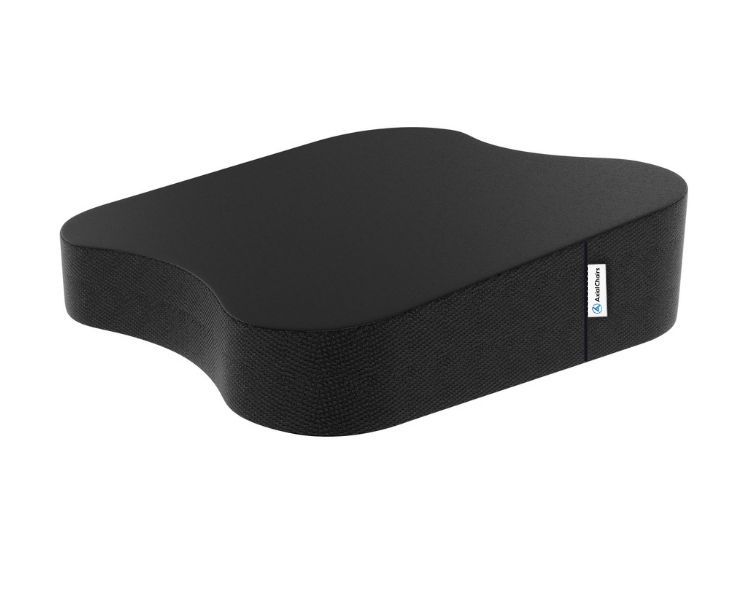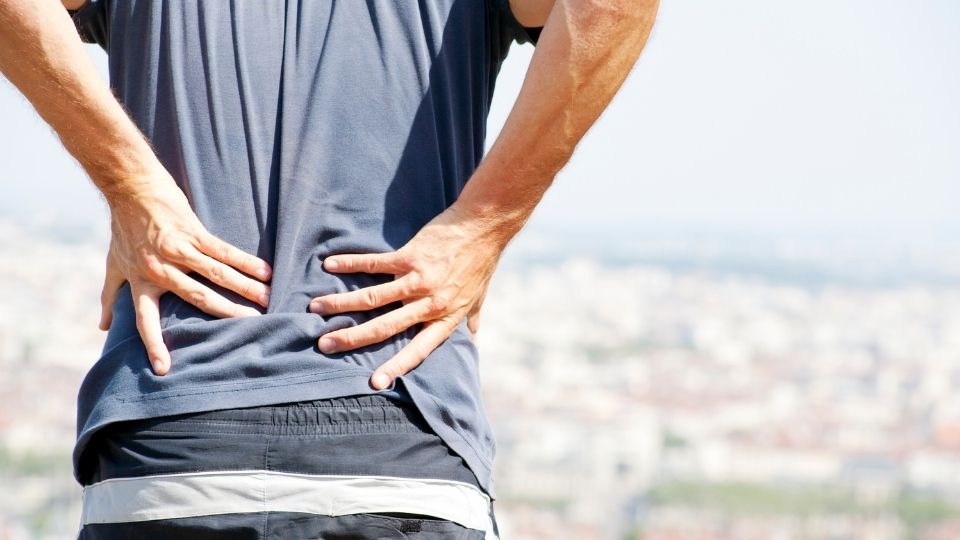As a doctor, I know firsthand how much pain can affect an individual’s life. Whether it be through acute injuries or chronic conditions, most people understand what it’s like to experience physical pain – and many of them are struggling with back pain when moving in certain directions. It’s essential to pay attention to your body when experiencing any kind of discomfort; constantly bending sideways can lead to increased aches and pains. In this blog post, I’ll explain what side-bending may mean for your spine health as well as suggest some ways that you can manage your uncomfortable symptoms and help prevent additional strain on the spine. Let’s dive in!
As a general rule, when you experience back pain when bending sideways, you should assess the pain severity. Minor pain may be a muscle spasm or strain; serious pain could indicate herniated disc or another injury. Seek medical attention for severe or persistent pain.
All Day Comfort & Support
Axial Ergonomic Seat Cushion® | Seat Chair Wedge
Quick Guide: A 30-Second Summary

All Day Comfort & Support
Product Name
Axial Designs™ Seat Cushion
Price
$149
Warranty
1 Year
Type
Posture Wedge
Top Layer
100% Natural Latex (Molded)
Bottom Layer
High-Density Foam
Top Material
Isometric Grippy Vegan Leather
Bottom Material
Non-Slip Material
Side Material
3D Breathable Fabric
Why does my back hurt when I turn to the side?
Bending your body sideways can cause lower back pain due to strain on the muscles, ligaments and discs in your spine. The strain occurs because of the extra load placed on these structures when your body is bent at an angle that it is not used to. As a result, you may experience pain in your lower back when you bend sideways. Additionally, if you have existing conditions such as arthritis or muscle spasms, these could also contribute to feeling back pain when turning to one side.
How do you know if back pain is muscular or spinal?
It can be difficult to determine whether your back pain is muscular or spinal in nature without consulting a medical professional. To assess whether it is muscular, pay attention to which movement causes the most discomfort and if it gets worse with certain positions or activities. Spinal issues often involve localized tenderness and stiffness after periods of rest or immobility. Pain due to spinal issues may also show up as radiating discomfort down into extremities such as legs and arms.
All Day Comfort & Support
Why does my back hurt when lying sideways?
Back pain while lying down sideways can be caused by structural changes within the spine due to ageing or injury, as well as poor posture during activities like sitting or standing for long periods of time. When lying down on one side, there might be more pressure exerted on structures like discs which are already weakened from wear and tear over time. This increased pressure could then lead to an increase in aches and pains for those who experience it.
Axial Ergonomic Seat Cushion® | Seat Chair Wedge
Quick Guide: A 30-Second Summary
Understanding the Link between Bending and Low Back Pain
When bending forwards or backwards, your lower spine undergoes certain changes that may lead to low back pain over time if proper form isn’t maintained during movement. For example, when bending forward with a rounded spine instead of keeping a neutral one (which typically involves engaging core muscles), there will be more stress put on muscles, joints, discs and ligaments which can then lead to chronic lower back problems later down the road.
Chronic Back Pain and Bending: How to Manage the Pain?
Managing chronic back pain involving bending requires both short-term relief measures as well as long-term strategies for prevention and improvement of overall function/ mobility. Short-term treatments include taking medications for inflammation/pain relief such as NSAIDs (nonsteroidal anti-inflammatory drugs) along with hot/cold applications depending on how acute the problem is at that moment in time (hot for muscle-related issues). In addition, physical therapy (PT) exercises focusing on strengthening core muscles so they can better support your spine while standing/moving should be done regularly in order to reduce recurrences of low back pain associated with bending activities over time.
Physical Therapy for Low Back Pain Due to Bending: What to Expect
When it comes to back pain when bending over, physical therapy can be an effective treatment option. Physical therapy can help to strengthen the muscles of the lumbar spine, improve flexibility and reduce pain. Depending on the cause and severity of lower back pain when bending sideways, your physical therapist may suggest stretching exercises and strengthening exercises for the core muscles. In addition, they may also recommend manual therapy techniques such as massage and joint mobilization to help reduce tension in the muscles and joints. Your physical therapist will work with you to create a customized plan that fits your individual needs and goals.

All Day Comfort & Support
Product Name
Axial Designs™ Seat Cushion
Price
$149
Warranty
1 Year
Type
Posture Wedge
Top Layer
100% Natural Latex (Molded)
Bottom Layer
High-Density Foam
Top Material
Isometric Grippy Vegan Leather
Bottom Material
Non-Slip Material
Side Material
3D Breathable Fabric
Lumbar Spine Pain and Bending: Causes and Treatment Options
Low back pain is often caused by inflammation of the spine or other health conditions affecting the spine such as arthritis or herniated discs. Pain may be felt when bending over due to increased pressure on the joints or muscle spasms in response to poor posture or incorrect lifting technique. Treatment options will depend on the underlying cause of the low back pain but may include lifestyle modifications such as avoiding activities that increase strain on your lower back, engaging in regular exercise, using heat/cold therapy and taking over-the-counter medications for milder cases.
Pain Management Strategies for Bending-Related Low Back Pain
For more severe cases of low back pain due to bending, medical intervention may be necessary. Medications such as anti-inflammatories can help manage pain levels while physical therapy can help with improving strength and flexibility in the area which will help reduce strain on the lower back. Other treatments such as trigger point injections, nerve blocks or epidurals may also be recommended by your healthcare provider if needed. Additionally, alternative therapies such as acupuncture have been found to be beneficial for some individuals with chronic low back pain when combined with other treatments like physical therapy.
How to Bend Properly to Avoid Low Back Pain: Tips and Tricks
To avoid developing low back pain from bending improperly there are several tips that can help you keep your spine healthy: maintain good posture throughout any activity; use correct lifting techniques; warm up before any strenuous activity; use proper ergonomics while sitting at a desk; take frequent breaks when performing repetitive tasks; strengthen core muscles regularly; wear comfortable shoes that provide adequate support; gradually increase the intensity of exercise programs; stretch regularly after activities; avoid heavy lifting without assistance where possible; practice deep breathing techniques during times of stress or tension; get regular medical check-ups if you are experiencing chronic low back pain symptoms. With these tips in mind, you should be able to reduce strain on your lumbar spine from bending and minimize the risk of developing chronic low back pain from improper movement patterns.
Back Pain: The Causes
Back pain affects millions of people worldwide and can be classified as either acute or chronic. Acute back pain typically lasts from a few days to a few weeks before easing, while chronic back pain lasts for over a year. The lower back is particularly susceptible to pain, and there are several causes, including:
- congenital skeletal abnormalities such as scoliosis, lordosis, and kyphosis
- degenerative conditions like arthritis, spondylosis, and disc degeneration.
- Other potential causes of low back pain include spinal problems like sciatica, ruptured discs, spinal stenosis, spondylolisthesis, and osteoporosis.
- Additionally, conditions like piriformis syndrome, fibromyalgia, endometriosis, pregnancy, and tumors can also contribute to back pain.
The chances of experiencing back pain can be influenced by various lifestyle factors. Individuals who sit for extended periods without proper back support, particularly those who are overweight, elderly, or who lead a sedentary lifestyle, are at an increased risk of developing back pain. Moreover, individuals who suffer from depression, anxiety, or stress may also be susceptible to back pain.
As a chiropractor, I suggest that individuals incorporate regular movement and exercise into their routine and use appropriate seat cushions to alleviate back pain. Additionally, getting adequate and quality sleep is crucial in maintaining a healthy back. To mitigate the risk of back pain, it is essential to maintain a good sitting posture throughout the day and adopt a proper sleeping position at night.
Back Pain: When To Take Immediate Action
While some cases of back pain can be relieved with self-care, others require medical attention. There are certain warning signs that indicate the need for prompt medical intervention, such as experiencing a fever with your back pain, numbness in your groin region, sudden weakness in your legs, loss of control over bladder or bowel movements, inability to find a comfortable sitting or standing position, and worsening pain instead of improvement over time.
Summary
In conclusion, back pain when bending sideways can be caused by many different ailments and conditions. Minor pain may be nothing more than a strained muscle, however, it is important to seek medical attention if the pain doesn’t go away or gets worse. Persistent or severe pain could indicate a herniated disc or other injury and should not be ignored. If you experience back pain when bending sideways, assess the severity of the pain and take appropriate action. By being aware of your body and taking action if necessary, you will help ensure you remain healthy and happy in the future.





